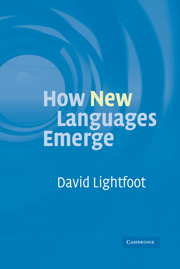Book contents
- Frontmatter
- Contents
- Preface
- 1 Internal languages and the outside world
- 2 Traditional language change
- 3 Some properties of language organs
- 4 Languages emerging in children
- 5 New E-language cuing new I-languages
- 6 The use and variation of grammars
- 7 The eruption of new grammars
- 8 A new historical linguistics
- References
- Index
1 - Internal languages and the outside world
Published online by Cambridge University Press: 02 February 2010
- Frontmatter
- Contents
- Preface
- 1 Internal languages and the outside world
- 2 Traditional language change
- 3 Some properties of language organs
- 4 Languages emerging in children
- 5 New E-language cuing new I-languages
- 6 The use and variation of grammars
- 7 The eruption of new grammars
- 8 A new historical linguistics
- References
- Index
Summary
Languages and the language capacity
Languages come and languages go. We deplore it when they go, because the disappearance of a language is a loss for the richness of human experience. These days, linguists are devoting much energy to documenting expiring languages. That documentation itself may increase the use of the language, which may increase its chance of surviving in some form. For example, simply finding a written version of a language facilitates its use for new purposes and new uses lead the language to be spoken more widely. Adapting computer software to accommodate the language may bring further advantages. Ultimately, however, people cease to speak a language because they come to identify with a different group, perhaps encouraged by factors of economic interest, perhaps influenced by governmental policy favoring one language above others in schools and official discourse.
Nettle & Romaine (2000: ⅸ) note that “the greatest linguistic diversity is found in some of the ecosystems richest in biodiversity inhabited by indigenous peoples, who represent around 4% of the world's population, but speak at least 60% of its 6,000 or more languages.” Expiring languages tend to be spoken by small, underprivileged groups that lack resources. The disappearance of languages is a complicated matter that began to generate widespread concern in the 1990s, when funds were invested in investigating the death of languages and efforts were made to document endangered languages.
- Type
- Chapter
- Information
- How New Languages Emerge , pp. 1 - 16Publisher: Cambridge University PressPrint publication year: 2006



